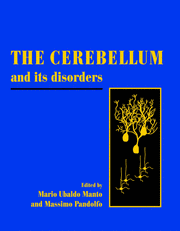Book contents
- Frontmatter
- Contents
- List of contributors
- Preface
- Acknowledgments
- Foreword by Sid Gilman
- PART I INTRODUCTION
- PART II THEORIES OF CEREBELLAR CONTROL
- PART III CLINICAL SIGNS AND PATHOPHYSIOLOGICAL CORRELATIONS
- 7 Clinical signs of cerebellar disorders
- 8 Pathophysiology of clinical cerebellar signs
- 9 The role of the cerebellum in affect and psychosis
- PART IV SPORADIC DISEASES
- PART V TOXIC AGENTS
- PART VI ADVANCES IN GRAFTS
- PART VII NEUROPATHOLOGY
- PART VIII DOMINANTLY INHERITED PROGRESSIVE ATAXIAS
- PART IX RECESSIVE ATAXIAS
- Index
7 - Clinical signs of cerebellar disorders
from PART III - CLINICAL SIGNS AND PATHOPHYSIOLOGICAL CORRELATIONS
Published online by Cambridge University Press: 06 July 2010
- Frontmatter
- Contents
- List of contributors
- Preface
- Acknowledgments
- Foreword by Sid Gilman
- PART I INTRODUCTION
- PART II THEORIES OF CEREBELLAR CONTROL
- PART III CLINICAL SIGNS AND PATHOPHYSIOLOGICAL CORRELATIONS
- 7 Clinical signs of cerebellar disorders
- 8 Pathophysiology of clinical cerebellar signs
- 9 The role of the cerebellum in affect and psychosis
- PART IV SPORADIC DISEASES
- PART V TOXIC AGENTS
- PART VI ADVANCES IN GRAFTS
- PART VII NEUROPATHOLOGY
- PART VIII DOMINANTLY INHERITED PROGRESSIVE ATAXIAS
- PART IX RECESSIVE ATAXIAS
- Index
Summary
Clinically relevant anatomy
The reader is referred to Chapter 2 of Part I for a detailed description of the anatomy of the cerebellum. Basically, the cerebellum is divided into ten lobules, which are shown in Fig. 7.1a. Two major fissures subdivide the cerebellum into three lobes: the anterior and posterior lobes are demarcated by a primary fissure, and a postero-lateral fissure separates the posterior lobe and the flocculonodular lobe (Fig. 7.1b; Gilman et al., 1981). This latter lobe is also called the vestibulocerebellum.
Mainly on the basis of phylogenetic studies, the cerebellum has been divided into archicerebellum, paleocerebellum and neocerebellum (Fig. 7.1c). There is an approximate relationship between this nomenclature and the projections of afferent pathways towards the cerebellum (Brodal, 1981). The term spinocerebellum is also used to designate paleocerebellum, because important projections are directed from the spinal cord towards the paleocerebellum, whereas the terms neocerebellum and pontocerebellum are used equally to designate this most recent part of cerebellum.
In clinical practice, there are basically three sagittal areas, including cortical and subcortical structures (Fig. 7.1d): a vermal zone in relation to the fastigial nucleus; a paravermal or intermediate zone associated with the interpositus nucleus; and a lateral zone whose Purkinje cells project to the dentate nucleus (Fig. 7.1d). Midline zone includes the vermis and flocculo-nodular lobe. Table 7.1 indicates main afferent and efferent pathways for each of these three sagittal zones. The three sagittal zones described here should not be confused with the sagittal bands of the cerebellum (see Chapter 2).
- Type
- Chapter
- Information
- The Cerebellum and its Disorders , pp. 97 - 120Publisher: Cambridge University PressPrint publication year: 2001
- 5
- Cited by

